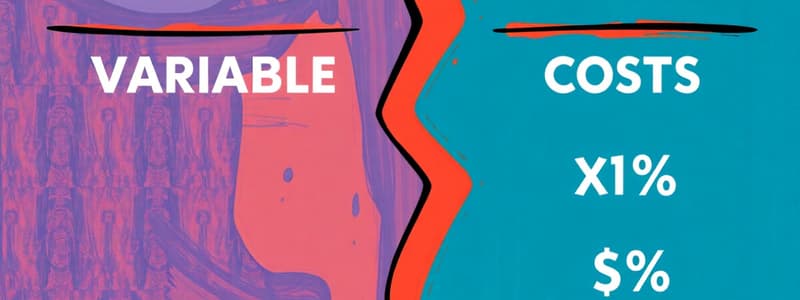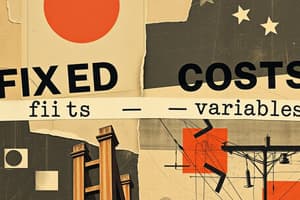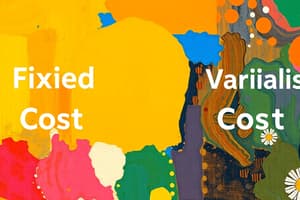Podcast
Questions and Answers
In the short run, a restaurant has a lease on its building (a fixed input), but can vary the number of servers (a variable input). If the restaurant unexpectedly experiences a large increase in customers, which of the following is most likely to happen initially?
In the short run, a restaurant has a lease on its building (a fixed input), but can vary the number of servers (a variable input). If the restaurant unexpectedly experiences a large increase in customers, which of the following is most likely to happen initially?
- Average fixed cost will decrease, and average variable cost will increase. (correct)
- Both average fixed cost and average variable cost will decrease.
- Average fixed cost will increase, and average variable cost will decrease.
- Both average fixed cost and average variable cost will increase.
A local bakery is considering increasing its production of cupcakes. Which of the following costs would likely be considered a variable cost?
A local bakery is considering increasing its production of cupcakes. Which of the following costs would likely be considered a variable cost?
- Depreciation of the baking equipment.
- Monthly rent for the bakery space.
- Cost of flour and sugar used to make the cupcakes. (correct)
- Annual insurance premium for the bakery.
A company producing widgets initially experiences increasing returns to scale, but as it continues to expand, it starts to face diseconomies of scale. What is the most likely cause for this transition?
A company producing widgets initially experiences increasing returns to scale, but as it continues to expand, it starts to face diseconomies of scale. What is the most likely cause for this transition?
- Technological advancements have made their production processes obsolete.
- The company is able to negotiate better deals with suppliers due to its increased purchasing power.
- Managerial inefficiencies and communication problems have arisen due to the firm's size. (correct)
- Increased specialization of labor is leading to higher productivity.
In the short run, a firm's total cost (TC) is $1200, and its total variable cost (TVC) is $800. What is the firm's total fixed cost (TFC)?
In the short run, a firm's total cost (TC) is $1200, and its total variable cost (TVC) is $800. What is the firm's total fixed cost (TFC)?
A small business owner is deciding whether to hire an additional employee. To make an informed decision, what should the owner primarily consider?
A small business owner is deciding whether to hire an additional employee. To make an informed decision, what should the owner primarily consider?
What is the key distinction between the short run and the long run in economics?
What is the key distinction between the short run and the long run in economics?
If increasing the quantity of all inputs by 20% leads to an increase in output by 30%, what is this an example of?
If increasing the quantity of all inputs by 20% leads to an increase in output by 30%, what is this an example of?
If a firm's marginal cost (MC) is consistently above its average total cost (ATC), what must be true about the average total cost?
If a firm's marginal cost (MC) is consistently above its average total cost (ATC), what must be true about the average total cost?
Which of the following is the most likely outcome of specialization and division of labor?
Which of the following is the most likely outcome of specialization and division of labor?
The law of diminishing returns primarily applies to which time period?
The law of diminishing returns primarily applies to which time period?
A company's total revenue (TR) is $500,000, and it sells 10,000 units. What is the average revenue (AR)?
A company's total revenue (TR) is $500,000, and it sells 10,000 units. What is the average revenue (AR)?
An automobile manufacturer is seeking to achieve economies of scale. Which of the following strategies would best help them accomplish this?
An automobile manufacturer is seeking to achieve economies of scale. Which of the following strategies would best help them accomplish this?
A firm is experiencing constant returns to scale. What does this indicate about the relationship between inputs and outputs?
A firm is experiencing constant returns to scale. What does this indicate about the relationship between inputs and outputs?
A small tech company decides to lease a larger office space in anticipation of hiring more employees. Initially, this leads to more collaboration and efficiency. However, as the company continues to grow, communication slows down and bureaucracy increases. What economic concept does this illustrate?
A small tech company decides to lease a larger office space in anticipation of hiring more employees. Initially, this leads to more collaboration and efficiency. However, as the company continues to grow, communication slows down and bureaucracy increases. What economic concept does this illustrate?
In the long run, a firm can avoid diseconomies of scale by doing what?
In the long run, a firm can avoid diseconomies of scale by doing what?
Assume a firm already owns a machine with a total life of 10 years. The cost of using the machine for one year to produce good X is:
Assume a firm already owns a machine with a total life of 10 years. The cost of using the machine for one year to produce good X is:
Which of the following is a fixed cost for a handmade furniture manufacturer?
Which of the following is a fixed cost for a handmade furniture manufacturer?
If the marginal cost is below the average cost, then
If the marginal cost is below the average cost, then
Economies of scale can be defined as large-scale production leading to
Economies of scale can be defined as large-scale production leading to
Minimum efficient scale is the point where
Minimum efficient scale is the point where
Assume a perfectly competitive firm is a price taker. Then what is their marginal revenue?
Assume a perfectly competitive firm is a price taker. Then what is their marginal revenue?
When does Average Revenue equal Marginal Revenue?
When does Average Revenue equal Marginal Revenue?
Why can diseconomies of scale arise?
Why can diseconomies of scale arise?
A business increases inputs by 80%, and sees an output increase of 80%. What is that an example of?
A business increases inputs by 80%, and sees an output increase of 80%. What is that an example of?
Flashcards
Fixed Costs
Fixed Costs
Costs that do not vary with the level of output in the short run.
Variable Costs
Variable Costs
Costs that change with the level of output produced.
Short Run
Short Run
A period where at least one input is fixed, limiting flexibility in production.
Long Run
Long Run
Signup and view all the flashcards
Law of Diminishing Returns
Law of Diminishing Returns
Signup and view all the flashcards
Opportunity Cost
Opportunity Cost
Signup and view all the flashcards
Average Cost (AC)
Average Cost (AC)
Signup and view all the flashcards
Marginal Cost (MC)
Marginal Cost (MC)
Signup and view all the flashcards
Total Variable Cost (TVC)
Total Variable Cost (TVC)
Signup and view all the flashcards
Total Fixed Cost (TFC)
Total Fixed Cost (TFC)
Signup and view all the flashcards
Average Fixed Cost (AFC)
Average Fixed Cost (AFC)
Signup and view all the flashcards
Average Variable Cost (AVC)
Average Variable Cost (AVC)
Signup and view all the flashcards
Marginal vs Average Cost
Marginal vs Average Cost
Signup and view all the flashcards
Constant Returns to Scale
Constant Returns to Scale
Signup and view all the flashcards
Increasing Returns to Scale
Increasing Returns to Scale
Signup and view all the flashcards
Economies of Scale
Economies of Scale
Signup and view all the flashcards
Division of Labor
Division of Labor
Signup and view all the flashcards
Container Principle
Container Principle
Signup and view all the flashcards
Diseconomies of Scale
Diseconomies of Scale
Signup and view all the flashcards
Managerial Diseconomies
Managerial Diseconomies
Signup and view all the flashcards
Minimum Efficient Scale
Minimum Efficient Scale
Signup and view all the flashcards
Long-Run Average Cost (LRAC) Curve
Long-Run Average Cost (LRAC) Curve
Signup and view all the flashcards
Total Revenue (TR)
Total Revenue (TR)
Signup and view all the flashcards
Average Revenue (AR)
Average Revenue (AR)
Signup and view all the flashcards
Marginal Revenue (MR)
Marginal Revenue (MR)
Signup and view all the flashcards
Study Notes
- Managing costs is a key business problem that economics addresses by analyzing fixed and variable costs.
- This lecture covers business costs and revenue.
Learning Objectives
- Identify different types of costs.
- Understand costs in the short run and long run.
- Define fixed and variable costs.
- Understand average, marginal, and total costs.
- Explain the law of diminishing returns.
- Explain economies of scale and total revenue.
Production & Costs: Short Run
- In the short run and long run, production involves fixed and variable inputs.
- The short run includes some fixed inputs.
- The long run involves all variable inputs.
The Law of Diminishing Returns
- Occurs when one or more inputs are held fixed.
- Beyond a certain point, additional units of a variable input will lead to diminishing extra output.
Costs and Inputs
- Costs relate to the productivity and prices of factors.
Fixed and Variable Costs
- Relate together to give the total costs
- Total Fixed Cost (TFC) is the fixed costs
- Total Variable Cost (TVC) varies according to the law of diminishing returns.
- Total Cost (TC) is calculated as TFC + TVC.
Marginal Cost
- Marginal Cost (MC) = ΔTC / ΔQ
- Marginal cost relates to the law of diminishing returns.
Average Cost
- Average Fixed Cost (AFC) = TFC / Q
- Average Variable Cost (AVC) = TVC / Q
- Average Cost (AC) = TC / Q = AFC + AVC
Relationship Between Average and Marginal Cost
- The shape of the Average Cost (AC) curve depends on the shape of the Marginal Cost (MC) curve.
- If the marginal cost equals the average cost, the average cost will not change.
- If the marginal cost is above the average cost, the average cost will rise.
- If the marginal cost is below the average cost, the average cost will fall.
Production & Costs: Long Run
- All inputs are variable in the long run.
- The scale of production can have constant or increasing returns to scale.
Economies of Scale
- Include specialisation and division of labor.
- Are indivisibilities.
- Relate to the container principle.
- Involve greater efficiency of large machines.
- Include by-products and multi-stage production.
- Include organisational & administrative and financial economies.
Economies of Scope
Diseconomies of Scale
- Include managerial diseconomies.
- Involve effects on workers and industrial relations.
- Include risks of interdependencies.
The Size of the Whole Industry
- External economies of scale
- External diseconomies of scale
Economies & Diseconomies of Scale
- Economies of scale are present up to a certain output.
- Diseconomies of scale occur when firms become very large.
Long-Run Average Cost
- The shape of the Long-Run Average Cost (LRAC) curve depends on the presence of economies or diseconomies of scale.
- Assumptions behind the LRAC curve include:
- Input prices are given.
- The state of technology and input quality are given.
- Firms operate efficiently.
Revenue Definitions
- Total Revenue (TR) = Price (P) × Quantity (Q)
- Average Revenue (AR) = TR / Q
- Marginal Revenue (MR) = ΔTR / ΔQ
Revenue Curves
- Revenue curves apply when firms are price takers with a horizontal demand curve.
- Average Revenue (AR)
- Marginal Revenue (MR)
Studying That Suits You
Use AI to generate personalized quizzes and flashcards to suit your learning preferences.




